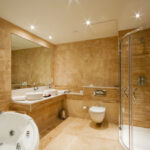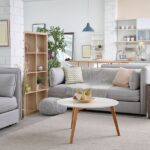Biophilic Design Trends: Bringing Nature Indoors
 I love nature, plants, gardening, –and even eating the fruits of my labor. Biophilic Design is a hip term to describe the growing interest in the incorporation of natural elements in our homes and offices. We believe it helps to reconnect the psyche with nature and can even revolutionize the way we think about our living and working spaces.
I love nature, plants, gardening, –and even eating the fruits of my labor. Biophilic Design is a hip term to describe the growing interest in the incorporation of natural elements in our homes and offices. We believe it helps to reconnect the psyche with nature and can even revolutionize the way we think about our living and working spaces.
1. Living Green Walls
Living green walls, also known as vertical gardens, are becoming increasingly popular in both commercial and residential spaces. These lush walls of vegetation not only add visual interest and beauty to a space but also provide numerous benefits, including improved air quality, noise reduction, and temperature regulation. Living green walls are a striking way to bring the beauty of nature indoors while also promoting health and well-being. Maintenance of living walls, though, might be a challenge for many as they attempt to keep the walls green, lush and healthy. I personally opt for well placed artificial green walls which can thrive even if I am away for weeks at a time. Moreover, they can be used both indoors and outside. If my traveling days were over, I might consider the challenge of a real green wall.
2. Natural Materials
Incorporating natural materials such as wood, stone, and bamboo into interior design has long been a hallmark of biophilic design. These materials not only add warmth and texture to a space but also create a connection to the natural world. From hardwood floors to stone countertops, using natural materials in interior design helps to create a sense of harmony and balance that is reminiscent of the outdoors.
3. Daylighting
Maximizing natural light in interior spaces, a concept known as daylighting, is another key element of biophilic design. Large windows, skylights, and strategically placed openings allow natural light to flood into a space, creating a bright and airy atmosphere. Daylighting not only reduces the need for artificial lighting but also has been shown to improve mood, productivity, and overall well-being. I have found that Solar Tubes can work as mini skylights at a fairly reasonable cost. You can buy the devices for less than $200, but installation would obviously be extra. These are great for bathrooms, closets or other dimly lit areas that might benefit from natural sunlight,
4. Indoor Plants
These are my favorites. I love orchids in both the bathroom and kitchen. Potted greenery flourishes in the sunroom. Bringing plants indoors is perhaps the most straightforward way to incorporate biophilic design into a space. From small potted plants to large indoor trees, incorporating greenery into interior spaces helps to create a sense of calm and tranquility. Indoor plants also have numerous health benefits, including improving air quality, reducing stress, and boosting productivity.
5. Water Features
I love the water element in my home, Water features such as fountains, ponds, and water walls are another popular biophilic design trend. The sight and sound of water can have a calming effect on the mind and body, making water features an excellent addition to interior spaces. Whether it’s a small tabletop fountain or a larger water wall, incorporating water features into a space helps to create a sense of serenity and relaxation.
6. Nature-Inspired Artwork
Artwork inspired by nature is another effective way to incorporate biophilic design into interior spaces. From landscape paintings to botanical prints, nature-inspired artwork brings the beauty of the outdoors indoors, creating a connection to the natural world. Artwork featuring natural elements such as plants, animals, and landscapes helps to create a sense of harmony and tranquility in interior spaces.
Conclusion
Biophilic design is more than just a trend; it’s a way of reimagining our built environments to better reflect our innate connection to nature. By incorporating elements such as living green walls, natural materials, daylighting, indoor plants, water features, and nature-inspired artwork into our interior spaces, we can create environments that promote health, well-being, and overall happiness. Whether it’s in our homes, offices, or public spaces, biophilic design has the power to transform the way we experience and interact with our built environment.
Incorporating biophilic design principles into your space can not only enhance its aesthetic appeal (and potential future sale) but also contributes to your well-being. Whether you’re redesigning your home or office, consider incorporating elements of biophilic design to create a space that is not only beautiful but also nurturing and inspiring.






